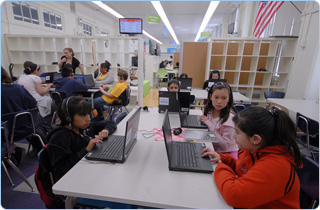Every day in a normal classroom, a math teacher stands up at the front of the room and lectures to students. The students who struggle sit in silent vigil while teachers continue foward, past the point where they got hung up. If the teacher is sick, tired or exhausted, they bring that up to the board with them to teach.
But what if you could change the way math learning is done?
What if a teacher was no longer responsible for teaching the lesson, but for monitoring that each student understands the lesson as it’s being taught?
A New Look on an Old Idea
In many ways the School of One is simply trying to combine resources and focus efforts to help students learn math more in a more strategic way.
Instead of having 4 math classes running during the same period of time, New York’s School of One combines teacher’s forces in a style that is reminiscent of some of the new classroom designs that gained popularity in the 1960’s and 1970’s but died out due to organizational issues. Still, School of One is optimistic that their program (which currently reaches 2,000 students in grades 6-8) will be able to change the way that students learn.
For one thing, in the 60’s and 70’s teachers didn’t have access to computers to make their experiments with one large learning environment seamless, measurable and consistent across the classroom. Perhaps the lack of technology is why those experiments failed and also why the School of One plan is succeeding.
Learning “Playlists”, Not Lectures
Inside a project one classroom you’ll find students are able to access over 5,000 online lessons from over 50 content providers. Students are able to access their lessons via a “playlist” loaded onto their Netbook. This playlist also includes metrics on where the student is at with the material so that teachers are easily able to intercede when a student becomes lost or confused with the material. Instead of teachers being responsible for managing every student’s learning and pace as a group, they act more like a mediator for students when they are in need of learning assistance.
Research and Results
Thus far the program appears to have been successful in helping students achieve higher scores. When you compare Project One students scores with the scores of unenrolled students, Project One students averaged a testing gain in math that is nearly approximate to having 1 extra year of study in the subject. Researches also found that when they controlled for the programs’ after school study program, Project One still showed significant gains of a quarter or half year’s amount of learning.
What’s exciting about these findings is that it indicates that students are thriving in a collaborative school environment. It also demonstrates that this type of collaborative and group learning environment only grows more effective when an after-school program is implemented. This is great news for tutors and learning centers that specialize in giving students customized learning experiences outside of the classroom day.
featured photo by school of one
SAT vs ACT: Choosing the Right Test [NEW EBOOK]
Download this free 20-Page Ebook for Tutors Now!
Our free 20-page ebook is a step-by-step guide on how to select the right test for your student. Learn everything you need to know about using the PLAN and PSAT to improve student scores, how to leverage learning analytics to select one test over the other, and other tips on how to take the guesswork out of selecting the ACT vs the SAT.











